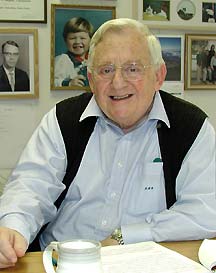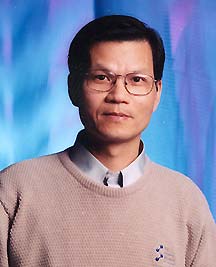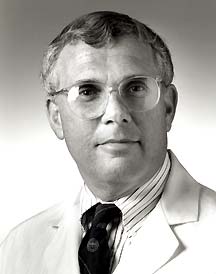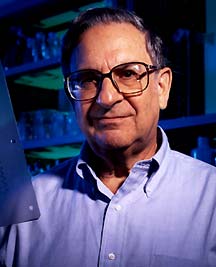Science Talk: Gleevec and Beyond
Last month, the Food and Drug Administration (FDA) approved
the drug STI571 (Gleevec from Novartis) as an oral treatment
for chronic myelogenous leukemia (CML), a chronic disease
in which too many white blood cells are produced in the bone
marrow. Approved by the FDA after an expedited review, Gleevec
is the first drug that turns off the signal of a protein known
to cause a cancer.
In the wake of the approval and the news coverage it garnered,
News&Views asked half a dozen faculty members of The Scripps
Research Institute (TSRI) who belong to the Cancer Affinity
Group—a group of scientists and medical professionals
in the area who sponsor an organized seminar series on cancer-related
topics—to comment on Gleevec, what it represents for
the future, and whether it has changed their thinking about
cancer targets.
 Immunology
Professor Ralph Reisfeld Immunology
Professor Ralph Reisfeld
One has to use the word "breakthrough" carefully,
because it has been used in the past, and, in my opinion,
false hopes were given. Not intentionally, but it resulted
in false hopes in patients. Having had cancer in my
own family, and knowing what it means to those people
afflicted by it, I am very careful not to raise any
false hopes.
More work has to be done, but what is terribly exciting,
at least to my understanding, is that Gleevec is the
fruit of extensive work on the Philadelphia chromosome
by many scientists who learned to target abnormal proteins
on tumor cells with molecular-targeting drugs. In fact,
in the early 1990s, scientists at CIBA-Geigy, later
Novartis Pharmaceuticals, were able to use a well-defined
target, the bcr-abl gene, located at the place
where chromosomes 9 and 22 are fused together. [They]
characterized its aberrant, cancer-causing protein.
They created Gleevec and designed it to shut off the
BCR-ABL protein in patients with chronic myelogenous
leukemia, or CML. This is an exciting area of research
since the powerful molecular technology now available
to scientists should lead to the discovery of correct
targets in other cancers. Several initiatives are underway
at the National Cancer Institute, such as the Cancer
Genome Anatomy Project, the Molecular Targets Initiative,
and the Molecular Classification of cancer.
A number of questions still need to be answered. These
include: How long does Gleevec control CML? Does Gleevec
actually cure patients of CML or does the drug delay
the onset of more advanced forms of cancer? If [the
latter], how long does Gleevec keep CML in check? Can
the effectiveness of Gleevec be increased in combination
with other drugs?
Gleevec may also target other cellular proteins such
as C-Kit and platelet-derived growth factor receptor
(PDGFR). A number of clinical trials are underway to
find other tumors that may respond to Gleevec, such
as gastrointestinal stromal tumor, glioma, and soft
tissue sarcoma.
|
 Immunology Professor Gary Bokoch
Immunology Professor Gary Bokoch
Gleevec is a good example of how our current knowledge
about how signaling pathways contribute to diseases
[can allow scientists] to target these pathways. It's
an amazing drug from what I've heard—remission
rates that are unheard of and very few side effects
so far. It opens up a lot of promising new areas of
research. I'm hoping that this will serve as an example
for [those in] the drug industry and will stimulate
them to think more deeply about going after signaling
molecules.
What Gleevec targets is a tyrosine kinase. It appears
that it is possible to get quite specific inhibitors
of kinases, and I think that we are going to be able
to use that fact to target a lot of different types
of kinase pathways regulated by proteins such as GTPases.
There are something like 100 tyrosine kinases, and there
are about 400 serine and threonine kinases, and [molecules
like the] GTPases are using these kinases to regulate
cell function.
The drug has proven what a lot of people in the signaling
field have tried to say to people working in therapeutic
areas: that signal transduction provides viable targets
to intervene in many types of disease processes.
|
 Chemistry
Professor Chi-Huey Wong Chemistry
Professor Chi-Huey Wong
[Gleevec] was developed to target a tyrosine kinase
associated with a leukemia. The time to FDA approval
was very short. It's quite an impressive story.
I think that kind of approach is very interesting—and
even more so in the future because of the information
we will get from genomic research. We may be able to
identify unique sequences or molecules associated with
cancers and those could be interesting targets for drug
development. The other important thing is to understand
how cancers are formed. It's still a puzzle.
|
 Chemistry
Professor K.C. Nicolaou Chemistry
Professor K.C. Nicolaou
Gleevec is a fantastic success story by Novartis. The
drug will help a population of patients suffering from
certain types of leukemia and gastrointestinal cancer.
Its widespread applicability remains to be seen, however.
The science behind this discovery is exemplary of the
modern drug discovery process in which biology identifies
and validates a target responsible for a given disease,
and chemistry designs and synthesizes small molecules
to bind and knock out the action of the culprit protein
target. With the human genome now deciphered, we will
have many more such biological targets to go after,
and with the sharpening of the tools of chemistry, the
drug discovery process will be faster and more precise.
New drugs will come out at an accelerated pace and will
possess more selective action and fewer undesirable
side effects.
With so many more anticancer drugs in the pipeline
and so much research underway, I am very optimistic
about the future. I am afraid, however, that magic drug
we need to cure cancer will not come tomorrow or all
at once. Such new drugs will continue to reach the patients
steadily, and, hopefully, sooner rather than later.
|
 Molecular
and Experimental Medicine Professor Bernard Babior Molecular
and Experimental Medicine Professor Bernard Babior
I think that [Gleevec] certainly changes the outlook
in terms of cancer chemotherapy, because it has a defined
target. Most chemotherapeutics are like hitting the
cancer with a sledge hammer. Gleevec is a much more
delicate approach. It has the potential to be a very
useful drug.
One thing I do have to say, though, is that it is
overrated. It has been advertised as the cure for chronic
myeloid leukemia (CML). Maybe it is and maybe it isn't,
but we won't know for some time to come.
There are a lot of treatments for CML. None of them
are specific like Gleevec, but all of them work for
awhile and then stop working. I imagine that there may
be a mutation in the BCR-ABL protein that would make
it insensitive to Gleevec, and then Gleevec would stop
working. Then the question is, "Is Gleevec going to
turn out to be better than, say, hydroxy urea or the
interferon, which are used now?" Interferon works for
awhile and then it stops working. And Gleevec could
work for awhile and then stops working. If it doesn't,
then it would be wonderful. It's conceivable that you
could even have a cure, but, to me, that would be a
big surprise because cancer cells can mutate to evade
treatment. My money would be against it.
The question is how long Gleevec works. If it works
longer than the present therapy, then you are in good
shape. You may not have a cure for cancer, but you would
likely have a much improved prognosis.
|
 Molecular
and Experimental Medicine Professor Ernest Beutler Molecular
and Experimental Medicine Professor Ernest Beutler
[Gleevec] represents the most concrete realization
of what medical scientists have been expecting to happen:
as we identify the molecular basis of cancer we will
be able to target some of the causative molecules. Thus,
this development hardly comes as a surprise. In fact,
maybe the most surprising thing is that it has taken
so long to find a target. Of course, we've been treating
targets all along but we haven't previously had as clear
an idea of what the targets were and how the drugs worked.
What's particularly elegant about this story is that
it demonstrates how basic understanding of a type of
cancer can ultimately lead to an effective treatment.
This story goes back about 40 years, and it has been
a succession of findings over those 40 years, not a
sudden insight, that has led to Gleevec—from morphology
to molecular biology to protein chemistry, and, finally
in the end, to the design of the drug.
This could be a model for other types of cancer. Most
medical scientists have the conviction that there will
not be a single cure for cancer. Cancer is due to a
series of perturbations of cell growth control, and
there are many different causes. As these causes get
identified, one can think seriously about interfering
or replacing the aberrant function and, in that way,
curing the cancer.
It's a first of sorts. It's an expected first, and
hopefully there will be a lot of others. This is the
reason why it is important to support basic research.
|

|
|

